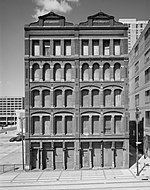National Museum of Ceramic Art
1989 establishments in Maryland1993 disestablishments in MarylandAccuracy disputes from March 2022Art museums disestablished in 1993Art museums established in 1989 ... and 2 more
Ceramics museums in the United StatesDefunct museums in Maryland
The National Museum of Ceramic Art (N.M.C.A.) was a non-profit arts institution active in downtown Baltimore, Maryland, in operation from 1989 until 1993.
Excerpt from the Wikipedia article National Museum of Ceramic Art (License: CC BY-SA 3.0, Authors).National Museum of Ceramic Art
West Pratt Street, Baltimore
Geographical coordinates (GPS) Address Nearby Places Show on map
Geographical coordinates (GPS)
| Latitude | Longitude |
|---|---|
| N 39.286388888889 ° | E -76.618611111111 ° |
Address
250 West Pratt Street
West Pratt Street 250
21201 Baltimore
Maryland, United States
Open on Google Maps








